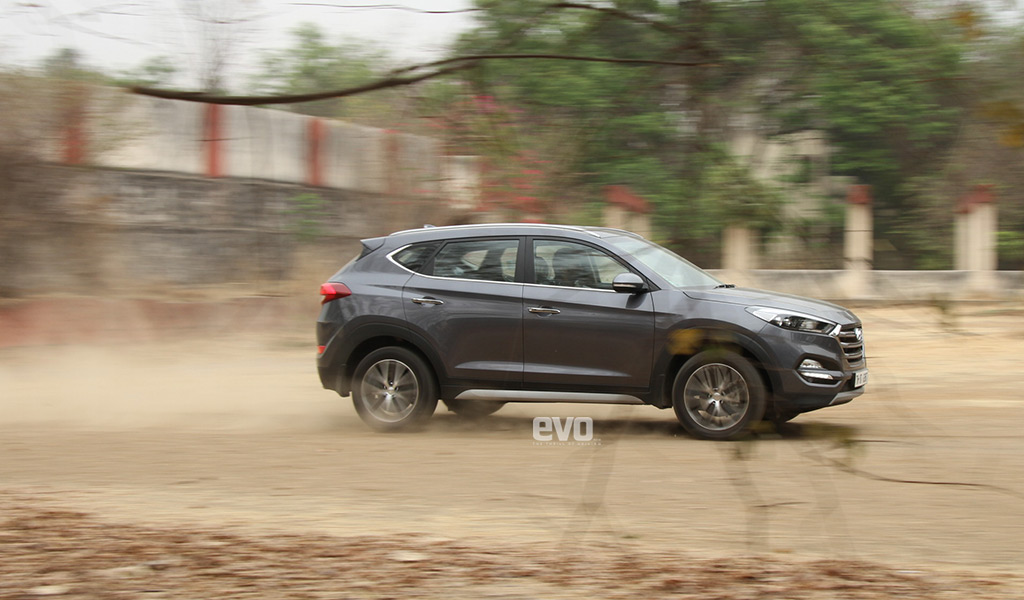Hyundai Tucson GLS 4WD review, test drive

The 4WD Hyundai Tucson
As you will have inferred from our long term test reports, the Hyundai Tucson is one of the more popular SUVs in our fleet. It looks great, has a lovely ride, unfussy dynamics, pleasing interiors and a fantastic music system that makes long drives a joy. The engine too is punchy and the automatic transmission, while not having the shift speeds of a twin-clutch, is well matched to the torque spread of the 2-litre diesel mill delivering refined shifts that are quick enough for an SUV of this class. It deserves to sell in stronger numbers than it currently does and to give it a boost it now gets the option of all-wheel drive.
 Traction has improved on gravel tracks
Traction has improved on gravel tracksAs with the regular front-wheel-drive Tucson the engine makes 185bhp and 400Nm of torque; there is no change in the outputs. But now, thanks to the 4WD, it does a much better job of putting its power down. Where the steering would squirm and front wheels spin up under hard initial acceleration on less-than-grippy tarmac, resulting in the ESC cutting in, the 4WD Tucson accelerates without any drama. It makes the Tucson feel peppier and more eager on acceleration runs, pulling out a further advantage over the VW Tiguan that, while 40bhp down on power, had the traction thanks to standard 4WD.
The improved traction on the 4WD Tucson become even more apparent on gravel tracks. This is probably the one area that we found our long term test Tucson lacking, on the last climb up to our farm house where we also test our rally cars the Tucson needed a good run up to build momentum lest it spin the front tyres and send a dust cloud towards the house. This 4WD Tucson does the climb without any drama and that makes it feel more like an SUV.
The 4WD is an on-demand system that is natively front-wheel drive and sends drive to the rear wheels only when it detects slip; technically it is an all-wheel drive system. However for slippery surfaces it also gets a 4WD lock that splits the power 50-50 front to rear so there’s no delay in the power going to the rear wheels. There is also hill descent control if you’re really thinking of going off-road though, truth be told, this is an SUV that works best on the road where the stable handling and polished road manners will be appreciated. Speaking of that hill descent, the added safety kit on the 4WD variant also filters down to the lower-GL-spec Tucsons that, in addition to Downhill Brake Control (DBC), get Electronic Stability Control (ESC) and Vehicle Stability Management (VSM).
 The Tucson gets 4WD lock and hill descent control
The Tucson gets 4WD lock and hill descent controlOn the road there really isn’t much to differentiate the 4WD Tucson from the FWD save the better traction when accelerating with vigor from traffic lights or toll booths, especially in Sport mode. What we did notice was the brakes now have better feel and aren’t as spongy on the Tucsons we have driven in the past and that is a welcome improvement. The handling remains safe and reassuring with good body control, not a great deal of body roll and a lifeless steering.
On the styling front there is nothing really to differentiate the 4WD Tucson apart from the badging on the (electrically operated) tailgate and that, we feel, is a miss. After all if you’re paying more for the 4WD variant (Rs 48,000) you want your SUV to scream it. It doesn’t get any extra kit over the regular Tucson either, not even a sunroof which we all expected the range-topper to get.
 The addition of 4WD has made the Tucson a well rounded package
The addition of 4WD has made the Tucson a well rounded packageAt Rs 25.19 lakh ex-showroom the 4WD Tucson slots between the Jeep Compass and Volkswagen Tiguan is only available in the top-spec GLS trim with the diesel-automatic. It’s a price that knocks on the doors of premium German brands and that, in the main, is why you don’t see too many Tucsons on the road. As for ability and capability the Tucson, now with the addition of 4WD, is an even better package and prospective buyers would be doing themselves a major disservice if this SUV isn’t at the top of their consideration list.


